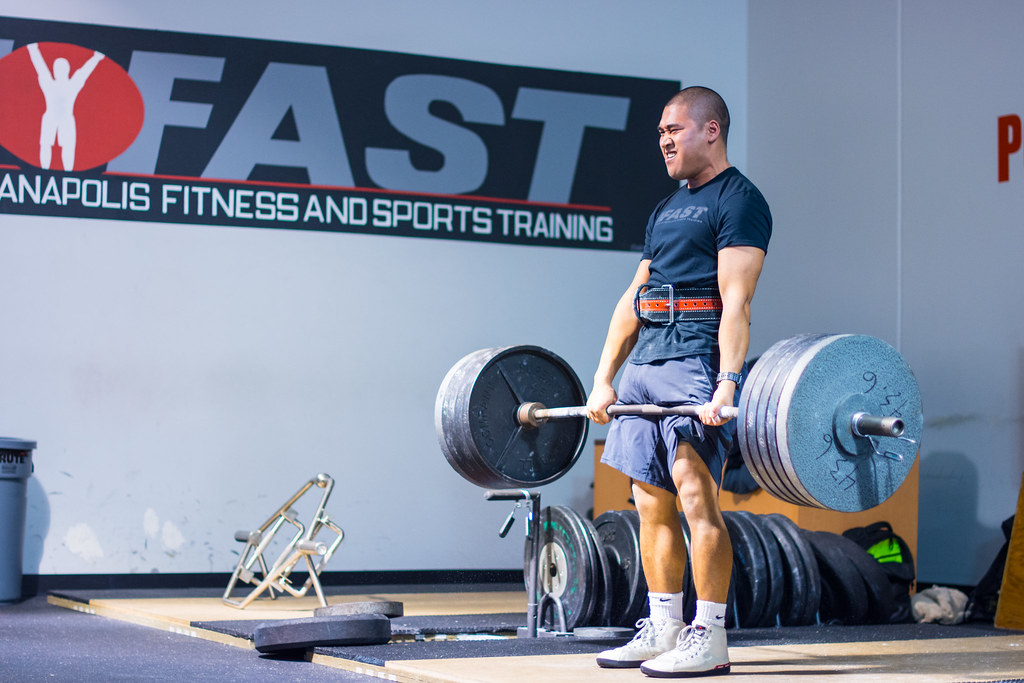Anyone who’s read this site for any length time knows I’m not a big fan of exercise variety.
For most people, most of the time, adding in novelty for the sake of novelty often mounts to nothing more than a one-way ticket to Averageville.
My good friend and strength coach, Chris Merritt (founder and owner of BSP NoVa), has an excellent guest post for you today discussing why exercise variety can be detrimental and how, despite popular belief, you can still keep your clients engaged with the same exercises.
His FREE e-book detailing how you can add variety to basic exercises can be downloaded HERE.

Why Introducing New Exercises Can Derail Progress
“No, get your back flatter … yeah, there you go, but drop your hips … okay, great job, but now get your back flat again … [hm, what the heck is going on?] … maybe set your feet wider?”
Whether you’re the coach or client, everyone is frustrated in a scenario like this, and yet, we’ve probably all been here at some point.
If you’re the client, I’m sorry, it’s not your fault.
If you’re the coach—you guessed it—this falls on you.
When it comes to selecting exercises for our clients, we actually shouldn’t have to coach form all that much. Sure, there’s some base level of teaching that needs to happen on the front end, and occasional cues along the way, but, contrary to what all too often happens across gyms far and wide, people don’t need the newest fancy exercise progression every time they get a new program.
In fact, continually introducing new movements will significantly slow down progress or, worse yet, derail it altogether.
Think about it…
The more time spent on coaching, teaching—whatever you want to call it—the less time the client spends training with appropriate focus and duration to accomplish their goals. Do you think the recipient of the coaching above was able to train with enough intensity (i.e., weight used) and volume (i.e., the total number of sets and reps) to even remotely elicit desired results?
… and we can argue about whether it was an exercise selection or coaching problem some other time.
[the correct answer is both]
Now let’s pretend that four to six weeks later they’re finally getting it, and then BAM!, their coach decides to switch things up to the latest squat variation they copped from Instagram.
… here we go again.
A Better System
At our gym, Beyond Strength Performance NOVA, we use a system of strength standards to determine when it’s potentially time to move on, and a subsequent progression of exercises that layer competency gained from the movement prior.
Let’s unpack what that actually means, using the deadlift as an example…

All our members start their training journey with a personal orientation session, typically done a day or two after their 1-on-1 assessment and goal-setting session, and we accomplish multiple things within the hour:
- Teach the warm-ups, providing context for basic concepts (position, breathing, tension, patterning) that carry right over into their everyday training…
- Teach them how to deadlift, squat, push, and pull, along with determining what variations and loads are best suited for them from day one…
- Teach the language we use to coach and cue across all our staff
- Have the new member work with multiple coaches in the session to introduce them to the concept of semi-private personal training
- Take them through a short training session with the four movements they just learned, allowing them to train that day and us to see how they took to the information they just learned…
- Set expectations for what’s to come…
- Make notes about their personality, learning style, and anything else that will help us to coach and connect with them…
Specific to the deadlift, we start the teaching process in our warm-ups by using the cat-cow drill to learn what it feels like to move through our spine and experience two undesirable positions that we refer to as “macho man”—extension, or belly dropped towards the floor—and “sad dog”—flexion, or a big arch like a scared cat.
We then introduce the position of “tall and tight”—ribs down and belt buckle to sternum—using the push-up position plank.
It’s also at this time that we’ll discuss “tall and tight” being our desirable position for all squats, deadlifts, rows, —essentially everything we do in the gym, with one of the only exceptions being the bench press, where we’ll use an arch, or “macho man.”
Finally, we use quadruped rocking to further provide the perception of what it feels like to move with our hips while staying “tall and tight.”
After the warm-ups we teach the deadlift, using a progression of handcuff hinge to barbell deadlift, stopping when we find the ideal starting point for their first program. Rather than write out the whole description of this process, let’s check out a video we filmed in May of last year for a law enforcement group we’re consulting with:
NOTE: The only thing we do differently since this video was filmed is introduce the barbell RDL before progressing to the rack pull, as we have found that folks learn to keep the bar tight to their thighs and groove the pattern with a top-down approach more easily than bending over to find the right position before beginning the movement—much like handcuff hinge before the kettlebell deadlift…
Further, we use a strength standard of EIGHT quality deadlifts with a 60kg kettlebell (132# for those of you searching for a calculator), performed for multiple quality sets, before progressing to the barbell RDL. The new member may clear this and move on during their personal orientation session, or they could require multiple phases of training to build the capacity.
So yes, you read that correctly—if they’re four months into training with us and they haven’t passed the kettlebell deadlift standard, that kettlebell deadlift is staying on every one of their programs until they do so. Then they’ll need to demonstrate proficiency with the barbell RDL before they go to the rack pull, and the proper form and mobility with descending rack pulls before maybe progressing to the floor.
Sounds boring, you say?
Feeling successful is never boring, and the basics allow for our folks to train with appropriate intensity, volume, and positions to crush their goals. But that doesn’t mean you can’t keep things interesting in your application of the basics.
How Many Ways Could You Program the Kettlebell Deadlift?
If you just thought of things like traditional sets and reps, partial reps, varied tempos, clusters, etc., you’re onto what we refer to as loading types.
Rather than just continually throw the kettlebell deadlift at you in the same fashion, month in and month out, we could do something like this:
- Elevated kettlebell deadlifts for the first month while we work on hip mobility. Further, we can prescribe more time under tension with the eccentric portion (descent) to really groove the pattern. We refer to this as straight sets with an eccentric focus…
- Elevated Kettlebell Deadlift (31X2) 2-3 x 8
- (31X2) = each rep performed with a 3 second descent, 1 second pause on the floor, up fast, and 2 second pause at the top. Do these 8 times and you’ve completed one set—one to two more sets to go depending on how you’re holding up with this new training stimulus.
- In month two we’re ready to ditch the elevation, however, we haven’t cleared the strength standard, so we’ll program clusters to build our capacity.
- Kettlebell Deadlift Clusters 3 x (2, 2, 1)
- (2, 2, 1) = 2 reps, rest 10 to 30 seconds, 2 reps, rest another 10 to 30 seconds, and finally 1 rep—all with the same weight. That’s one set, and you’ve got two more to go.
- For month three, let’s put weight ladders to use.
- Kettlebell Deadlift Descending Weight Ladders 3 x (3 heavy, 2 medium-heavy, 1 medium-light)
- Perform 3 heavy kettlebell deadlifts, right into 2 medium-heavy kettlebell deadlifts, followed by 1 medium-light kettlebell deadlift. That’s one set down, two to go.
- In month four we bring it back to straight sets, only this time with no elevation…
- Kettlebell Deadlift 4 x 4
- … and for example, let’s say you want to test out in week 4. We’ll simply switch your 4 x 4 to 2 x 8. Crush it, and on to the barbell RDL we go…
All For One and One For All
We have strength standards for our core four movements—squat, deadlift, push-up, and pull-up—and progressions/regressions for every exercise we use.
When we put these systems to use in our program design process—appropriately selecting individual exercises and combining them in a manner to work towards the clients’ said goals—coaches don’t need to overwhelm the clients with constant corrections, clients get to see a pathway to success and train their asses off in the process, and decision making with regards to writing one program to the next becomes a simple task.
It’s just plain better for everyone involved.
Want More?
 You can learn all about 20+ loading types, providing YEARS of near infinite variety on the basics by picking up my free e-book, “You Can’t Get Bored: Adding Variety to the Basics of Program Design,” by simply providing your email here.
You can learn all about 20+ loading types, providing YEARS of near infinite variety on the basics by picking up my free e-book, “You Can’t Get Bored: Adding Variety to the Basics of Program Design,” by simply providing your email here.
And if you’d like to come learn this stuff in person—and so much more—join us on Sunday September 9th in Queens, NY at Iron Lion Performance for the Program Design One-Day Deep Dive Seminar. Check out the agenda and get registered here.
Beyond that, feel free to email me anytime! [email protected].



 the strength volume down? Yeah, baby, I am.
the strength volume down? Yeah, baby, I am. While they may not have the same sexy appeal as advanced techniques like German Volume Training, or High-Frequency Strength splits, concurrent splits are the way to go when programming for general pop clients. Sure, super-specific training blocks may get our folks faster results, but their narrow focus doesn’t do our folks any favors in the long run.
While they may not have the same sexy appeal as advanced techniques like German Volume Training, or High-Frequency Strength splits, concurrent splits are the way to go when programming for general pop clients. Sure, super-specific training blocks may get our folks faster results, but their narrow focus doesn’t do our folks any favors in the long run.


